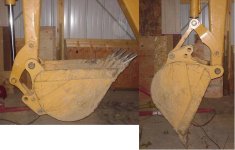its fairly simple statics
the hardest part is measureing the angles and distances.
in the case of the linkage, they simply provide a link to change the angle at which the force acts on the lever arm. (and or generate diffrent ranges of motion)
the red angle can be broken down from its vector from to 2 forces parrell and perpendcular to the arm (parrrell force on arm you toss out) perpendcular force (yellow) acts on the moment arm green (distance between the pins)
to find the break out force at the teeth, (second yellow line) you must take the moment around the pin (were the two green lines intersect)
M=Force*distance.
so F(breakout) = M(around pin)/distance from pin to teeth
PS youll need some trig to translate the purple number into the red number and the red number into the yellow number
NOTE: as the angle of the bucket changes, more (or less) force from the purple line is transfered to the red line, because of this the breakout force changes durring the entire sweep of the bucket.
if your really good youll slove the above 3 bar linkage problem in generic form, then plot the results to see how the force varries, then you could tell us the peak break out force and at what angle it occurs at. (hears a hit, its when the angle of the red linkage is directly in line with the purple cylinder force)
also remember that cylinder push/pull values are not the same due to area diffrences. In the case of an FEL bucket, your breakout force (upward) is the weaker of the 2 cylinder values. (this is the exact oppisite as shown in the hoe example above)

